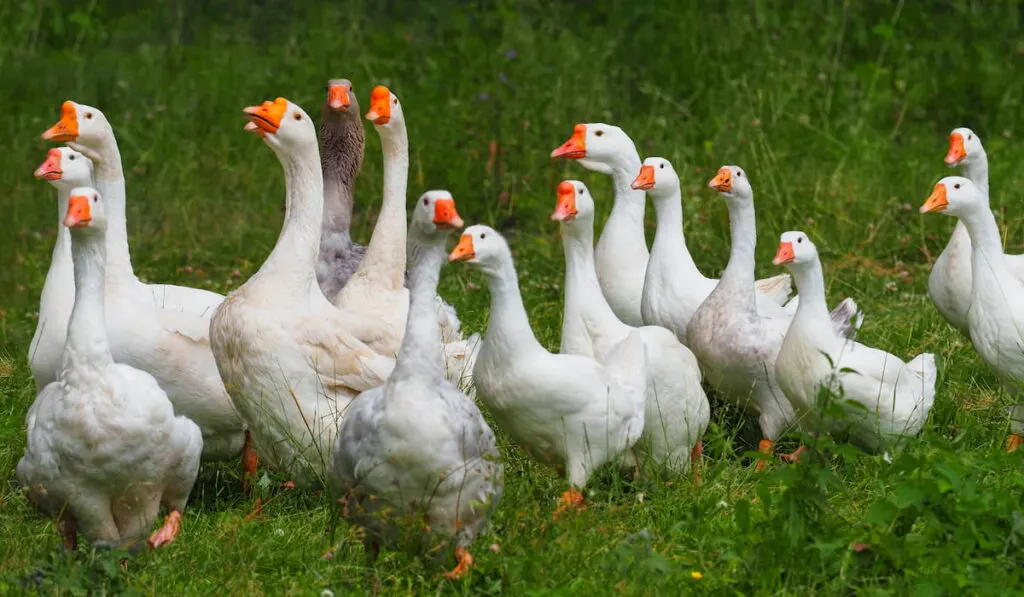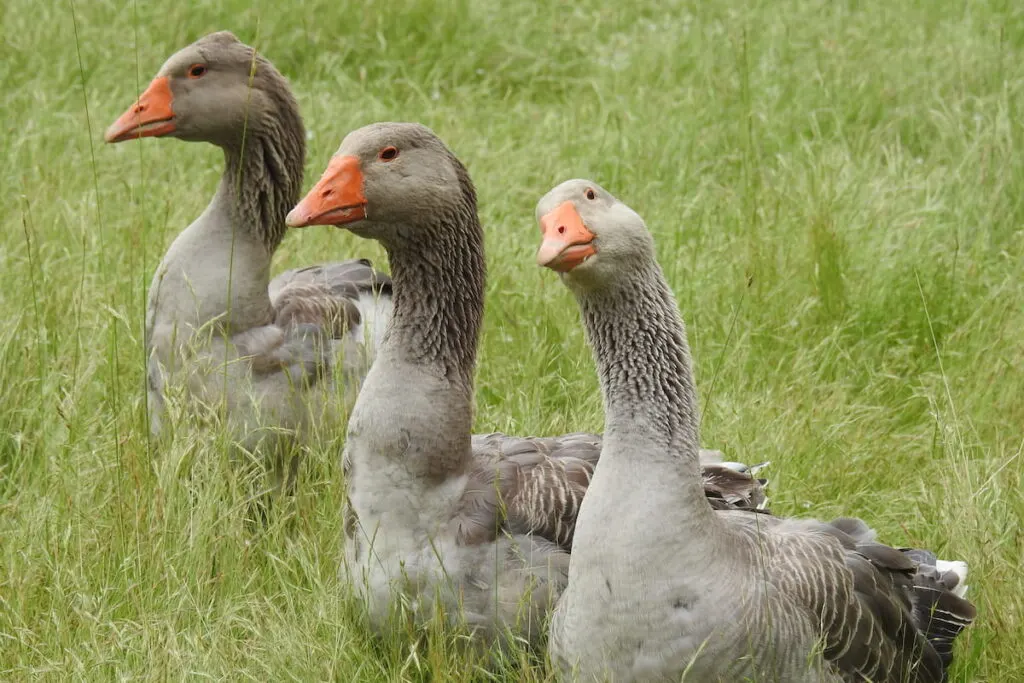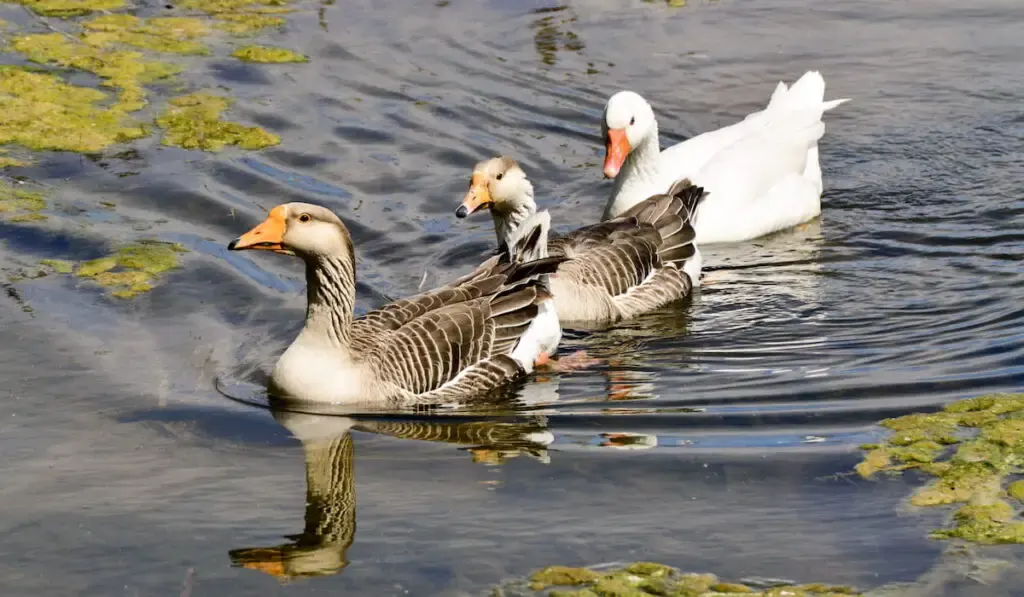If you are a lover of birds or poultry, and you would like to add geese to your family of birds, or you want to start off totally as a newbie bird owner, stick around. This article was written with you in mind.
Geese are birds adapted for both land and water. They are the second-largest waterfowl and are closely related to swans and ducks. Geese have webbed feet which help them paddle effectively in water, moderately long legs, and flat bills.
They are mostly herbivorous in nature with plants constituting most of their daily diet. Some species are also known to consume insects and other invertebrates and are often found grazing alongside cattle and sheep in backyard farms.
Not all species of geese have been domesticated. Most domestic geese breeds have been created from the two species to be domesticated first: the Greylags and Swan geese.
Geese can be raised successfully in the backyard in a free-range system, which is great news for beginners as you do not necessarily need to build a poultry house or barn.

Geese vs. Other Poultry Birds
Geese, ducks, quails, chickens, and turkeys are all common domestic birds in our environment. They have common characteristics, but also possess distinctive features.
- As opposed to chickens who lay their eggs in any space they feel secure irrespective of where it may be, geese create large nests under sheltered areas where they lay their eggs.
- Chicken feet are single and separated, adapted for digging and searching the soil, while geese have webbed feet perfect for wading through mud and water.
- Ducks and chickens will sit on their eggs immediately after they lay them, while geese usually wait for their eggs to accumulate up to a dozen before they sit to incubate them.
Why you Should Have Geese on Your Farm
- Geese can be friendly when raised from goslings and will chatter while grazing all around the farm.
- They are an excellent source of meat. Roast goose was often a staple at holiday celebrations throughout history.
- They are good at providing eggs.
- They also double as guardians for your smaller animals as they are known to stage a fight with some predators such as hawks and weasels.
8 Great Goose Breeds for Beginners
- African Geese: Despite their name, this breed actually traces its origins to Asia, with China being the most likely place.

African geese usually have black knobs at the top of their beaks, but are sometimes orange in some strains. They can be loud, with an upright stance, and protective nature.
They are primarily reared for meat, but can also be reared for eggs.
One important thing to note is that this breed should not be exposed to extreme cold as they are susceptible to frostbite and need to be kept warm during the winter.
They usually range from 18 – 22 lbs, where the females are much smaller than the males.
2. Toulouse Geese: This goose breed is known as one of the tallest breeds with a very calm and placid disposition. They are on the top of the goose breed list for beginners.

However, mixing other breeds with the Toulouse breed is not advisable as they have a domineering streak. They are quite easy to take care of as they do not need too much attention.
Toulouse geese are happy wandering around the farm and do not necessarily try to escape beyond borders, especially if they’re very comfortable in their allotted space. They are not an aggressive breed and will need defense from possible predators and nosy kids.
They are mainly used for the production of meat and sometimes eggs. They produce an average of thirty eggs in a year.
3. Sebastopol: These are a very unique breed of geese. Sebastopols are usually identified by their white unkempt feathers that can make them look like walking clouds. They also occur rarely in grey variants.

Sebastopol geese were first raised in Europe for the sole purpose of being show birds. They do require some special care when it comes to keeping them, such as shelters that are warm during the winter, and clean water for them to swim in.
Sebastopols are quite a talkative breed, and they may be annoying when you need some peace and quiet. They are primarily raised as guardians, but they are also good sources of eggs and meat.
They can lay between twenty-five to thirty-five eggs in a year.
4. Embden Geese: Embden geese are very large and white in color, possessing prominent orange bills and orange feet.

They originated from Germany and are known to be very heavy. Because of their size, they are reared primarily for meat purposes.
Embdens are a quiet breed, you may even forget they are around due to the little amount of sound they make. This attribute also makes them good pets and farm animals for beginners.
Their egg production ranges from thirty to forty in a year.
5. Guinea Goose: This goose breed originated from Africa. It is a very easy bird for amateur breeders to get hold of, especially at poultry fairs.
They have very colorful feathers which spread from the head to their tail. They are rarely reared for their eggs as they only lay about fifteen eggs per year.
These geese are very protective of their young, making a loud piercing cry at the sign of danger. This cry is very different from the sound of other geese and may be surprising at first, but is known to scare off predators.
In short, this goose is perfect for a beginner breeder who wants to own beautiful birds without many challenges.
6. Chinese goose: The Chinese goose will fit your farm either as weeders or as guardian geese.
They have a prominent knob on their bill just like the African goose, which is more prominent in males than in females.
However, you can say goodbye to your peace of mind once these birds arrive on your farm as they are one of the loudest breeds of geese. They are best reared in rural areas and not in the urban zones.
However, their sounds can serve as an alarm against attacks from predators. They’re like mini guard dogs.
This breed is also known for its proficient grazing, which makes them great weeders.
Chinese geese are recorded to have up to 100 eggs per year, making them one of the best layers.
7. Ethiopian Blue-winged goose: As the name implies, this breed originates from Ethiopia. They are known to be very sociable and approachable, calm, and sometimes curious.
They are mainly terrestrial and will enter a lake only if they want to wash up or in times of danger. Ethiopian Blue-winged geese can live in groups without any problems and will live with other birds peacefully.
The Blue-winged are not picky eaters and will generally graze on grass. This breed is a simple one which is perfect for beginners wishing to have very colorful subjects. They require little or no attention, especially in terms of food.
8.Pilgrim: The Pilgrim goose is a very special breed of goose. They are quite similar to other breeds, but they are very different in the fact that they can be auto-sexed or identified as male or female at hatching.

Pilgrims were first developed in Iowa, with grey adult females and white adult males with orange bills.
Pilgrim geese are average in weight, and are often reared for egg production which can be up to 40 eggs in a year.
They are also deft weeders like the Chinese goose. They are very quiet and calm birds and are sometimes referred to as the friendliest goose breed.
Tips for Taking Care of Your Geese
- Water: Unlike popular opinion, you don’t need to have a whole pond to keep your geese happy. A plastic tub with enough water to sit themselves in will do the trick.
- Grass is their main diet. A healthy field with a variety of grasses is perfect for geese.
- Keep a mini shed or shelter for them to retire whenever they want.
- Have fencing around your property that will prevent them from straying off and wandering away.
As a beginner in goose rearing and keeping, above is a list of friendly breeds you may want to consider starting off with. They are quite easy to maintain and require little care and attention.

